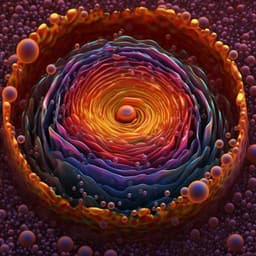
Physics
Direct observation of a few-photon phase shift induced by a single quantum emitter in a waveguide
M. J. R. Staunstrup, A. Tiranov, et al.
This groundbreaking research by Mathias J. R. Staunstrup and colleagues unveils an optical phase shift of 0.19 ± 0.03 radians when a weak coherent state interacts with a single quantum dot in a nanophotonic waveguide. With implications for high-efficiency optical switching and quantum machine learning, this work paves the way for future advancements in photonic integrated circuitry.
~3 min • Beginner • English
Introduction
The study addresses how to directly measure and harness the few-photon, emitter-induced optical phase shift in nanophotonic waveguides, a key nonlinearity for quantum information processing, quantum networking, and photonic neural networks. Prior approaches using free-space focusing or atomic ensembles achieved only small phase shifts due to limited light–matter coupling, while cavity-based systems increase coupling but add complexity and bandwidth constraints. Nanophotonic waveguides with embedded quantum dots (QDs) offer near-unity coupling efficiencies and scalability, enabling strong nonlinear interactions. The research question is whether one can directly and interferometrically measure a sizable, photon-number-sensitive phase shift from a single QD in a waveguide, characterize its power-dependent nonlinearity and saturation, and assess its implications for deterministic quantum operations.
Literature Review
Emitter-induced phase shifts have been observed with atomic ensembles and trapped single atoms/ions, but free-space coupling limited single-emitter phase shifts to only a few degrees. High-finesse cavities (free-space and nanophotonic) enhanced coupling and enabled larger phase shifts, albeit with increased experimental complexity and narrow bandwidth. Solid-state emitters in nanocavities have shown significant phase shifts via Purcell enhancement, though confined to cavity linewidths. Waveguide QED platforms offer high β-factors and scalable integration; however, prior direct Mach–Zehnder measurements reported only small phase shifts with molecules due to coupling constraints. Indirect phase reconstructions via heterodyne/Floquet methods achieved larger shifts (up to ~0.37 rad in cavity-embedded molecules), but required model-dependent fitting. Recent photon-scattering reconstructions inferred sizable phase shifts (~0.22π) indirectly. This work fills the gap by providing a direct interferometric measurement of the phase in a nanophotonic waveguide QD system.
Methodology
- Device and sample: An InGaAs quantum dot embedded in a GaAs photonic crystal waveguide (PCW) with radius 70 nm and lattice constant 250 nm. The PCW bandgap is positioned ~−0.5 THz from the emission wavelength, giving weak Purcell enhancement but high β-factor. Shallow-etched grating couplers (typical efficiency >25%) are used for in/out-coupling with suppressed back-reflections. The QD resonance is tuned via the DC-Stark effect using an applied voltage; the off-resonant state (0.8 V) avoids any active transitions, and the on-resonant state is at 1.24 V.
- Interferometric setup: A ~3 m Mach–Zehnder interferometer is built atop a closed-cycle cryostat (sample at 4 K). A continuous-wave resonant laser is sent through the arm containing the PCW and QD; the output interferes with a local-oscillator (LO) reference arm. The measured interferometer visibility is ν = 0.65, limited by imperfect mode matching to the grating output. The interference signal is detected on a single-photon avalanche photodiode (SPAD). To stabilize the long interferometer against sub-wavelength vibrations and drifts, a high-power locking laser (far detuned) is co-propagated and separated by a grating filter at detection. Feedback locking uses a piezo-mounted mirror driven by an FPGA-based lock-in and PID controller; mirror/piezo response bandwidth ~4 kHz; lock modulation at 3.1 kHz.
- Excitation and locking lasers: The locking laser is blue-detuned by 7.5 nm from the QD transition (~941 nm), at higher power than the resonant few-photon probe, ensuring no interaction with the QD while maintaining good sample transmission. The resonant probe laser is swept in frequency across the QD transitions to retrieve phase and transmission spectra.
- Measurement protocol: Interference fringes are recorded while toggling the QD between on- and off-resonance by Stark tuning, enabling direct extraction of the QD-induced phase shift and intensity modulation. Integration time is 100 ms per point for representative traces. Phase and transmission spectra for the two neutral-exciton dipole transitions are fitted simultaneously to a waveguide-QED model to extract maximal phase shifts and linewidths. Power-dependent (saturation) measurements are performed by repeating spectral scans at multiple probe powers and fitting to a saturation model to infer nonlinear response and saturation parameters.
- Theory context: In a bidirectional (isotropic) waveguide with coupling efficiency β, for a lifetime-limited emitter with decay rate γ, the single-photon transmission coefficient t yields a phase φ = arg(t). The maximal single-photon phase shift on resonance can reach π/2 for β → 1; for β ≠ 1, the phase is maximized at detuning Δ = ±γ/2 with φ_max = tan^−1(β/(2√(1−β^2))). Chiral (directional) coupling can in principle yield a maximal phase shift of π with unity transmission at resonance.
Key Findings
- Direct interferometric measurement of the phase shift induced by a single quantum dot in a nanophotonic waveguide. Extracted maximal phase shifts for the two neutral-exciton dipoles: φ_max,1 = (−0.06 ± 0.03)π rad and φ_max,2 = (−0.19 ± 0.03)π rad. The latter corresponds to ≈ −0.60 rad (≈ −34°), about thirty times larger than previous direct Mach–Zehnder measurements.
- Simultaneous extraction of transmission spectra and phase demonstrates consistent behavior with waveguide-QED theory; interferometer visibility ν = 0.65 was sufficient to resolve narrow spectral features.
- Nonlinear saturation of the phase response: saturation power for the transition P_sat ≈ 0.15 mW (from model); the maximal phase shift saturates around 0.14 mW. Estimated mean photon number interacting with the QD within its lifetime at saturation is n_e ≈ 0.39, well below one photon per lifetime, evidencing few-photon nonlinearity.
- Measured linewidths of the two dipole transitions: 1.95 ± 0.05 GHz and 1.45 ± 0.05 GHz.
- Methodological performance: locking laser detuned by 7.5 nm from 941 nm; feedback bandwidth ~4 kHz; lock modulation at 3.1 kHz; grating coupler efficiency typically >25%.
- The results validate that interferometric measurements can directly access single-photon phase responses in waveguides and highlight the potential for even larger shifts in lifetime-limited and chiral coupling regimes (up to π/2 and π, respectively).
Discussion
The findings directly address the challenge of observing and quantifying emitter-induced phase shifts in integrated waveguides. The measured few-photon phase response confirms strong light–matter interaction with a single QD and demonstrates a practical route to nonlinear photonic operations. The phase shift magnitude is currently constrained by coupling efficiency (β < 1) and residual dephasing/broadening of the QD. With lifetime-limited transitions, isotropic coupling could approach π/2 phase shifts; chiral (directional) coupling promises up to π with essentially unity transmission at resonance, enabling deterministic phase operations invisible to intensity-only measurements. The observed saturation at sub-single-photon flux underscores the nonlinearity’s suitability for quantum applications such as photon sorting, quantum non-demolition detection, and photonic quantum gates. Moreover, theory predicts abrupt phase transitions versus drive strength and dephasing in chiral geometries, suggesting uses in ultra-sensitive phase switching and environmental sensing. Overall, the work establishes a scalable interferometric protocol for on-chip characterization of quantum nonlinearities essential for quantum information processing and quantum optical neural networks.
Conclusion
The work introduces and demonstrates a robust interferometric method to directly measure few-photon phase shifts from a single quantum emitter in a nanophotonic waveguide, reporting a record direct phase response for this platform. By mapping both phase and transmission across QD resonances and characterizing power-dependent saturation, the study validates strong few-photon nonlinearity compatible with integrated photonics. Future directions include: (i) realizing fully lifetime-limited QD transitions to approach π/2 phase shifts; (ii) engineering chiral coupling in waveguides to reach π phase shifts with deterministic transmission; (iii) exploiting abrupt phase dynamics for all-optical phase switches and decoherence sensing; and (iv) integrating multiple emitters for scalable on-chip quantum gates, quantum non-demolition measurements, generation of optical Schrödinger-cat states, and components for quantum optical neural networks.
Limitations
- Phase shift magnitude is limited by non-ideal light–matter coupling (β < 1) and residual dephasing/broadening of the QD emission lines, reducing the achievable φ_max relative to the π/2 ideal in isotropic coupling.
- Interferometer visibility (ν = 0.65) and mode-matching imperfections reduce signal-to-noise and measurement precision.
- The method’s sensitivity is constrained by available signal intensity and integration time per point.
- Cavity-free waveguide configuration offers broader bandwidth than cavities but lacks Purcell enhancement, making decoherence channels more impactful on φ_max.
- Chiral coupling, which could enable π phase shifts with unity transmission, has not yet been simultaneously demonstrated with high β-factor in waveguides.
Related Publications
Explore these studies to deepen your understanding of the subject.







